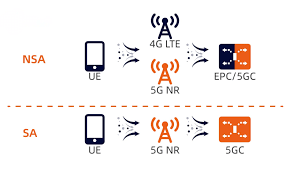
New Radio or Stand Alone

Stand Alone or New Radio
image ©iplook.com5G in UK - the 4 mobile operators, EE, O2, 3UK and Vodafone each bought frequencies to be able to run a 5G network. This involved building a whole new network including the radio and core aspects of the network. The introduction of 5G coincided with various financial constraints (Covid Pandemic and the requirement to remove Huawei from the core network). The operators therefore plan to introduce 5G in two stages.
5G NR = 5G New Radio. [sometimes called 5G NSA - Not Stand Alone] The simplest way to get 5G up and running and showing some results was to build the 5G radio network on 4G masts, and use the 4G backhaul to transfer the data back and forward to the core. The effect was effectively to add capacity to the 4G radio network, with a lot of new and not conflicting nodes onto the 4G network. This is what the operators did to get 5G up and running with a lower cost base. It also explains the 'complaints' that 5G was not significantly faster than 4G. Whilst this was 5G it is not 'real' 5G.
5G SA = 5G Stand Alone. To achieve the expected speeds latency and desirable features of 5G changes were needed to the core network. The latest 5G network have a completely separate core network; separate to the 4G core. This has the effect of speeding up the transmission and improving the latency. As part of te process some the core features have moved to the edge which adds to the improvements of the network.
© mobilephonetechnology.co.uk all rights reserved 2017-2025
